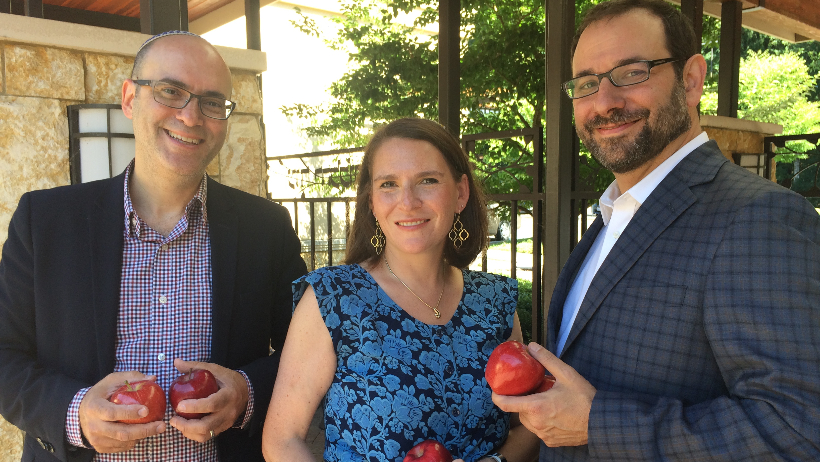Holidays and Festivals
Learn more about the holidays that make up the Jewish calendar and how they’re celebrated. Prior to each holiday, more information will be posted on the events calendar.

Major holidays
Rosh Hashanah
Rosh Hashanah literally means “head of the year,” and marks the beginning of the Jewish New Year. It falls at the beginning of the month of Tishrei and lasts for two days. It is a time of reflection and celebration, as the Book of Life is opened and each person’s fate for the year is written. It is the start of the High Holy Days (Days of Awe), which culminate in Yom Kippur. Rosh Hashanah is marked with the blowing of the shofar, special services at the synagogue, and eating apples dipped in honey.
Yom Kippur
Falling on the 10th day of Tishrei, Yom Kippur is the Day of Atonement at the end of the High Holy Days. Observed with a 25 hour fast and special services at synagogue, this is the day that the fate written in the Book of Life on Rosh Hashanah is sealed for the year. Yom Kippur is the holiest and most solemn day of the year for Jews. The focus of the day is on repentance for previous misdeeds, and is to be spent in intensive prayer. Dressing in white and blowing the shofar for the final time also mark the day
Sukkot
Beginning five days after Yom Kippur, Sukkot commemorates the wandering of the Israelites and the yearly thanking for the completed harvest. Lasting for eight days, Sukkot is named for the dwellings Israelites lived in during their 40 years of wandering. Farmers would also live in sukkahs during their harvest. It is observed by building the sukkah – a three-sided structure with a thatched or branched roof. During the first day of Sukkot, the Four Species of plants – palm, etrog, lulav, and willow – are shaken to celebrate the harvest bounty.
Simchat Torah
Simchat Torah is on the 23rd day of Tishrei, and is the second day of Shemini Atzeret. It is the day that celebrates the ending of one cycle of Torah reading, and the beginning of the next. It is marked with lots of dancing and singing, especially at the peak of the day when everyone dances with the Torah in circles around the synagogue. It is also the only time when Torah is read at night, and in the morning all members are called to an aliyah.
Passover/Pesach
Pesach begins on the 15th day of Nisan, last for eight days, and celebrates the liberation of the Jews from slavery in Egypt. One of the major preparations for the holiday is a deep-cleaning the home, and removing all traces of leavening from the house for the duration of Pesach. The central tradition of Passover is the seder, a ritual meal involving the consumption of matzah and symbolic foods on the seder plate. The story of the exodus is told during the seder, with the help of the Haggadah.
Shavuot
Occurring on the sixth day of Sivan, Shavuot celebrates the early summer grain harvest and the receiving of the Torah on Mount Sinai. Taking place 50 days after the first seder of Passover, Shavuot is also called the Feast of Weeks. The Book of Ruth is read, and some participate in Tikkun Leil Shavuot – an all-night Torah study session that follows the holiday meal. Traditionally, dairy and cheese products are eaten on Shavuot in celebration.
Minor holidays
Tu B’Shevat
Tu B’Shevat takes place on the 15th day of Shevat, and is known as the New Year of the trees. Also called the “birthday’ of the trees, it’s celebrated by planting trees, and having a seder. The Tu B’Shevat seder ritual involves eating four fruits and drinking four cups of wine following a hand washing to recognize the significance of the trees’ bounty and the changing of the seasons in the year.
Lag B’Omer
Lag B’Omer is marked on the 18th day of Iyar, which is also the 33rd day of counting the Omer. A day of joy in the middle of a sad season, Lag B’Omer commemorates the dual occasion of death of Rabbi Simeon bar Yohai, a disciple of Rabbi Akiva and the ceasing of a plague on Rabbi Akiva’s students. Bonfires are lit to symbolize light of Simeon bar Yohai’s life and it is also a popular wedding day as it is the only day during the Counting of the Omer that celebrating is permitted.
Purim
Purim is the Feast of Lots, and is observed on the 14th day of Adar. Told in the Book of Esther, Purim recounts the story of Queen Esther saving the Jewish people from Haman, a royal advisor who had plans to destroy them. Purim is celebrated with the giving of gifts to friends and the poor, dressing in costume, and the reading of the Megillah. Hamantaschen are traditionally baked in preparation for the holiday.
Chanukah
Chanukah, the Festival of Rededication begins on the 25th of Kislev and lasts for eight days. Observed by lighting the candles of a Chanukiah each night, it recognizes the rededication of the temple in Jerusalem after its desecration in 164 BCE. Turned into a pagan shrine by the Greeks, the Jews cleaned and rededicated it, celebrating with an eight-day festival. Chanukah festivities include playing games of dreidel and eating dairy and oil-fried foods like sufganiyot and latkes.



